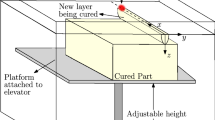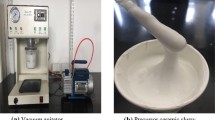Abstract
In the recoating process of the high-viscosity ceramic stereolithography, a large amount of ceramic paste is accumulated in front of the blade, and the fluidity of the high-viscosity ceramic paste is poor. The blade imposes forces on the solid part below, which deforms the fine structures of the part, affecting the accuracy of the part. In the actual printing process, slender rod parts appear T-shaped. This paper aims to investigate the causes of this phenomenon and to predict the deformation rate of a part. The understanding of the deformation phenomena can be used as theoretical guidance for dimensions or support sizes when modeling parts. A two-dimensional model has been developed to study high-viscosity materials with non-Newtonian fluid properties and slender rod parts, using the phase field method and a dynamic mesh to restore the recoating process. An experimental setup, which mimics the recoating process in the high-viscosity ceramic stereolithography process, has been used to verify the results of simulations. The results show the force exerted by the blade only affects the top portion of the slender rod part, and that the time of greatest impact on the deformation is the moment when the blade is reaching the top of the slender rod, generating a deformation rate that is cubic to the height of the slender rod.











Similar content being viewed by others
References
Chen Z, Li Z, Li J (2019) 3D printing of ceramics: A review. J Eur Ceram Soc 39:661–687. https://doi.org/10.1016/j.jeurceramsoc.2018.11.013
Thakar CM, Parkhe SS, Jain A et al (2022) 3d Printing: Basic principles and applications. Mater Today Proc 51:842–849. https://doi.org/10.1016/j.matpr.2021.06.272
Kalyan BP, Kumar L (2022) 3D Printing: Applications in Tissue Engineering, Medical Devices, and Drug Delivery. AAPS PharmSciTech 23:1–20. https://doi.org/10.1208/s12249-022-02242-8
Shahrubudin N, Lee TC, Ramlan R (2019) An overview on 3D printing technology: Technological, materials, and applications. Procedia Manuf 35:1286–1296. https://doi.org/10.1016/j.promfg.2019.06.089
Hwa LC, Rajoo S, Noor AM, Ahmad N, Uday MB (2017) Recent advances in 3D printing of porous ceramics: A review. Curr Opin Solid State Mater Sci 21:323–347. https://doi.org/10.1016/j.cossms.2017.08.002
Chen Z, Sun X, Shang Y, Xiong K, Xu Z, Guo R, Cai S, Zheng C (2021) Dense ceramics with complex shape fabricated by 3D printing: A review. J Adv Ceram 10:195–218. https://doi.org/10.1007/s40145-020-0444-z
Zhang F, Li Z, Xu M, Wang S, Li N, Yang J (2022) A review of 3D printed porous ceramics. J Eur Ceram Soc. https://doi.org/10.1016/j.jeurceramsoc.2022.02.039
Wang F (2019) Research progress of 3D printing materials in stomatology. IOP Conf Ser Earth Environ Sci 332:032013. https://doi.org/10.1088/1755-1315/332/3/032013
Ma Z, Xie J, Shan XZ, Zhang J, Wang Q (2021) High solid content 45S5 Bioglass®-based scaffolds using stereolithographic ceramic manufacturing: Process, structural and mechanical properties. J Mech Sci Technol 35:823–832. https://doi.org/10.1007/s12206-021-0144-9
Li X, Chen Y (2021) Vat-photopolymerization-based ceramic manufacturing. J Mater Eng Perform 30(7):4819–4836. https://doi.org/10.31399/asm.hb.v24.a0006578
Quan H, Zhang T, Xu H, Luo S, Nie J, Zhu X (2020) Photo-curing 3D printing technique and its challenges. Bioact Mater 5:110–115. https://doi.org/10.1016/j.bioactmat.2019.12.003
Li J, An X, Liang J, Zhou Y, Sun X (2022) Recent advances in the stereolithographic three-dimensional printing of ceramic cores: Challenges and prospects. J Mater Sci Technol. https://doi.org/10.1016/j.jmst.2021.10.041
Zhang Z, Li P, Chu F, Shen G (2019) Influence of the three-dimensional printing technique and printing layer thickness on model accuracy. J Orofac Orthop/Fortschr Kieferorthop 80:194–204. https://doi.org/10.1007/s00056-019-00180-y
Rasaki SA, Xiong D, Xiong S, Su F, Ldrees M, Chen Z (2021) Photopolymerization-based additive manufacturing of ceramics: A systematic review. J Adv Ceram 10:442–471. https://doi.org/10.1007/s40145-021-0468-z
Schmidleithner C, Kalaskar DM (2018) Stereolithography. In:3D printing. IntechOpen, Rijeka 1–22. https://doi.org/10.5772/intechopen.78147
Yao L, Hu P, Wu Z, Liu W, Lv Q, Nie Z, Zheng H (2021) Comparison of accuracy and precision of various types of photo-curing printing technology. J Phys Conf Ser 1549:032151. https://iopscience.iop.org/article/. https://doi.org/10.1088/1742-6596/1549/3/032151/meta
He L, Song X (2018) Supportability of a high-yield-stress slurry in a new stereolithography-based ceramic fabrication process. Jom 70:407–412. https://doi.org/10.1007/s11837-017-2657-3
Thomas H, Gregor VB, Bram DJ, Pascal E (2017) A trade-off analysis of recoating methods for vat photopolymerization of ceramics. 2017 Int Solid Freeform Fabrication Symp. University of Texas at Austin. https://hdl.handle.net/2152/89873
Kobayashi K, Lkuta K (2005) Development of free-surface microstereolithography with ultra-high resolution to fabricate hybrid 3-D microdevices. IEEE Int Symp Micro-Nano Mechatron Human Sci 2005:273–278. https://doi.org/10.1109/MHS.2005.1590003
Wu ML, Zhao WH, Li JC (2002) Study on the thickness of light-curing rapid prototyping resin coatings. J Xi'an Jiaotong Univ 1:47–50. https://doi.org/10.3321/j.issn:0253-987X.2002.01.012
Xu GS, Ma X, Jin J, Qiu R, Shen L (2009) Research on Recoating Process in high-resolution stereolithography system. 2019 Second Int Conf Intell Comput Technol Autom 4:621–624. https://doi.org/10.1109/ICICTA.2009.864
Wang YN, Xu GS, Jv KL, Jin KK, Luo S (2015) Study of coating technology in surface exposure rapid prototyping systems. Manuf Technol Machine Tools 1:153–156. https://doi.org/10.3969/j.issn.1005-2402.2015.01.039
Polfer P, Fu Z, Breinlinger T, Roosen A, Kraft T (2016) Influence of the doctor blade shape on tape casting—Comparison Between analytical, numerical, and experimental results. J Am Ceram Soc 99:3233–3240. https://doi.org/10.1111/jace.14343
Renap K, Kruth JP (1995) Recoating issues in stereolithography. Rapid Prototyp J. https://doi.org/10.1108/13552549510094223
Kozhevnikov A, Kunnen RP, van Baars GE, Clercx HJ (2019) Investigation of the fluid flow during the recoating process in additive manufacturing. Rapid Prototyp J. https://doi.org/10.1108/RPJ-06-2019-0152
Kozhevnikov A, Kunnen RP, van Baars GE, Clercx HJ (2020) Influence of the recoating parameters on resin topography in stereolithography. Addit Manuf 34:101376. https://doi.org/10.1016/j.addma.2020.101376
Wang H, Hu K, Lu K, Zheng Z, Lu Z (2022) Experimental and numerical analysis on the leading-edge bulge effect during the recoating process in ceramic stereolithography. Addit Manuf 51:102652. https://doi.org/10.1016/j.addma.2022.102652
Delhote N, Baillargeat D, Verdeyme S, Delage C, Chaput C (2007) Ceramic layer-by-layer stereolithography for the manufacturing of 3-D millimeter-wave filters. IEEE Trans Microw Theory Tech 55:548–554. https://doi.org/10.1109/TMTT.2007.891690
Bae CJ, Halloran JW (2011) Integrally cored ceramic mold fabricated by ceramic stereolithography. Int J Appl Ceram Technol 8:1255–1262. https://doi.org/10.1111/j.1744-7402.2010.02568.x
Zhang G, Zou B, Wang X, Yu Y, Chen Q (2022) Design, manufacturing and properties of controllable porosity of ceramic filters based on SLA-3D printing technology. Ceram Int. https://doi.org/10.1016/j.ceramint.2022.09.076
Chen T, Wang D, Chen X, Qiu M, Fan Y (2022) Three-dimensional printing of high-flux ceramic membranes with an asymmetric structure via digital light processing. Ceram Int 48(1):304–312. https://doi.org/10.1016/j.ceramint.2021.09.105
CFD Module Users Guide (2021) COMSOL Multiphysics® v. 6.0. COMSOL AB, Stockholm, Sweden, 280–305
Carsten T (2004) Process errors and aspects for higher resolution in conventional stereolithography. 2004 Int Solid Freeform Fabr Symp. https://doi.org/10.26153/tsw/6995
Ruschak KJ (1985) Coating flows. Annu Rev Fluid Mech 17:65–89. https://doi.org/10.1146/annurev.fl.17.010185.000433
Pham DT, Ji C (2003) A study of recoating in stereolithography. Proc Inst Mech Eng C J Mech Eng Sci 217:105–117. https://doi.org/10.1243/095440603762554659
Author information
Authors and Affiliations
Contributions
Kexin Zhang: simulation, methodology, experiment, writing- original draft preparation. Bingshan Liu: writing—review & editing, supervision, resources. Tao Li: material Guoyu Luo: simulation guidance Shan Li & Wenyan Duan: materials instruction, experimental instruction Gong wang: resources.
Corresponding author
Ethics declarations
Ethical approval
Not applicable.
Competing interests
The authors declare no competing interests.
Additional information
Publisher's note
Springer Nature remains neutral with regard to jurisdictional claims in published maps and institutional affiliations.
Rights and permissions
Springer Nature or its licensor (e.g. a society or other partner) holds exclusive rights to this article under a publishing agreement with the author(s) or other rightsholder(s); author self-archiving of the accepted manuscript version of this article is solely governed by the terms of such publishing agreement and applicable law.
About this article
Cite this article
Zhang, K., Liu, B., Li, T. et al. Simulation and experimental analysis on the deformation rate on slender rod parts during the recoating process in high viscosity ceramic stereolithography. Int J Adv Manuf Technol 124, 349–361 (2023). https://doi.org/10.1007/s00170-022-10540-5
Received:
Accepted:
Published:
Issue Date:
DOI: https://doi.org/10.1007/s00170-022-10540-5




